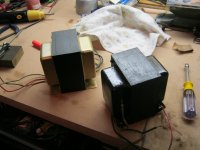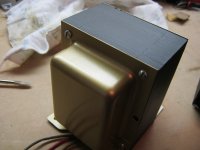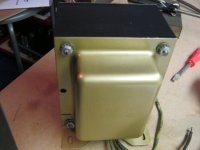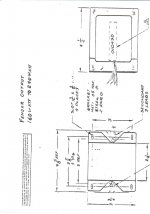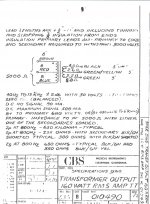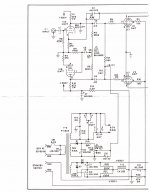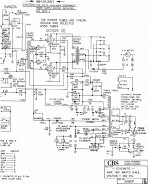There is also the heat issue.
Pretty neat looking. Though, at the point that you have all those holes to drill, perforated aluminum might be easier.
I bought these from a Fender design engineer and he is sending me the specs. and a copy of the schematic used for these. He is also sending me the PS for this project.
They are rated for 175/200w ea, I seen the specs and they were made for Fender in the late 70s. The spec sheet says right on it they are a 175/200w output transformer.
Randell was the manufacture and he was taking and I tried to write it down
Chocks are 10-12 henerys @ 200
OPT
500-600v at the plate.
he said 2 x 6550 = 100w and 4 x 6550 would get about 160-180w
His website! Famous Musicians & Risson
This is the guy I am talking about. He has built amps for the best of music scene. He is very well versed in tube amps of all kinds and he says he is not steering me in the wrong direction. I trust him and am just going off what was told to me. Please go look at his site and then decide if he is telling me the truth that these 12.5lb OPT will produce 200w
WO
It is worth considering that transformers and circuits that excel for guitar are not necessarily good for HiFi. An amp for guitar has a different set of requirements than for home HiFi.
However, let's wait and see what the transformers are when you get the specs.
Doing the arithmetic (linear scaling by volume) I would say that 12.5 lb'r is 200 Watt at 40 Hz. 40 Hz also being a typical low freq. spec for guitar amps. If it has enough turns to meet a 20 Hz low end (inductance), then the watts rating would depend on how hot they are willing to run the wire in the xfmr. at full power. OTs don't generally run at full tilt all the time, so the power rating can be increased for peaks.
Last edited:
E string at 39Hz...MI designers......makes sense to cut down weight and design around this.
rule of thumb...... go down to 20Hz and the core size doubles. If you want to listen to the lowest notes of Widor's Toccata, the tubes are going to struggle with a saturated transformer core.
rule of thumb...... go down to 20Hz and the core size doubles. If you want to listen to the lowest notes of Widor's Toccata, the tubes are going to struggle with a saturated transformer core.
<snip> If you want to listen to the lowest notes of Widor's Toccata, the tubes are going to struggle with a saturated transformer core.
My favorite organ piece.
This brings up an interesting question on how audio OTs are power rated.
I think Edcor mentions something about some ---? circular mils of copper per amp design spec. The Radio Amateurs Handbook mentions 700 CM/A as typical for small xfmrs, but 500 to 1000 CM/A as commonly used for power xfmrs. Assuming the designer puts enough turns on the thing to meet the inductance and magnetic saturation requirements, the only thing left to tie down (copper resistance now set by the winding window space) is the current thru it and how hot it will get.
The CM/A guidlines are for power transformers which could be expected to have constant max power thru them. But an OT has the advantage of the Crest factor (peak to avg. ratio) for typical audio. Even power transformers for SS audio amps take advantage of this. According to D. Self in "Audio Power Amplifier design handbook", manufacturers typically design the power xfmr for 70% of the rated power (power supply caps carry the peaks). Some of the industrial step-down xfmrs are rated for 100 degree C temp rise (could cook eggs on them) by using special hi-temp insulation.
I would certainly expect typical guitar OTs to take advantage of some Crest factor scaling since they are built to the lowest cost possible. Seeing as how the 12.5 Lb'r maps out to a full 200 Watt at 40 Hz with no Crest factor included, it could be designed (greater # of turns ) for a lower freq. spec (30 Hz? or 20 Hz?) and some Crest factor allowance. Just would have higher winding resistance than the typical Edcor or Hammond.
I think Edcor mentions something about some ---? circular mils of copper per amp design spec. The Radio Amateurs Handbook mentions 700 CM/A as typical for small xfmrs, but 500 to 1000 CM/A as commonly used for power xfmrs. Assuming the designer puts enough turns on the thing to meet the inductance and magnetic saturation requirements, the only thing left to tie down (copper resistance now set by the winding window space) is the current thru it and how hot it will get.
The CM/A guidlines are for power transformers which could be expected to have constant max power thru them. But an OT has the advantage of the Crest factor (peak to avg. ratio) for typical audio. Even power transformers for SS audio amps take advantage of this. According to D. Self in "Audio Power Amplifier design handbook", manufacturers typically design the power xfmr for 70% of the rated power (power supply caps carry the peaks). Some of the industrial step-down xfmrs are rated for 100 degree C temp rise (could cook eggs on them) by using special hi-temp insulation.
I would certainly expect typical guitar OTs to take advantage of some Crest factor scaling since they are built to the lowest cost possible. Seeing as how the 12.5 Lb'r maps out to a full 200 Watt at 40 Hz with no Crest factor included, it could be designed (greater # of turns ) for a lower freq. spec (30 Hz? or 20 Hz?) and some Crest factor allowance. Just would have higher winding resistance than the typical Edcor or Hammond.
Excess copper resistance in o/p push pull primaries is bad for HiFi but not an issue for MI (who cares how it is wound and often sounds best for the tone); a higher Cu resistance implies higher thd + increased losses. Generally Bmax for p-p o/p trannies is around 0.7T and mains over 1T. So not unusual to see a chassis with an o/p tranny larger than a mains. Jenoch the combination of power and frequency range.
Laws of physics, the LF size is determined by classic formula;
Bmax= L*I/N(Ae*e-4m) or equation rearranged to find Ae, the cross sectional core area, and with N turns and freq added:-
So Ae in metres sqr'd = Vac/4.44 Bmax, F, N; of course there's a heck of alot more to this.
After rounding off all the equations at the LF end, we arrive at a 1.4% iron distortion F2 criteria which determines the f-3dB i.e design cutoff freq of tranny and the culmination of Steinmetz's hysteresis Law. Hence professional mixing desks force the signal though a low Ae toroid to accentuate F2 (artifical bass) to make the bass sound fuller where LS system cutoff is above 40Hz. This is important for moden day small stereo designs as F2 creates an artifical bass sound which has profound selling & marketing issues. This was standard magnetic stuff worked out on a slide rule when I did it in HSchool in the early 1960's.
So there are differences in output transformers used for HIFi and MI. One can use an o/p tranny for MI, but in essence one has wasted ones money for quality one never is going to use.
Dunno these days. The Kudos is "what fits runs regardless of cost ethos." Morality gone out of the window... The thing is, nothing has really changed, not even the materials, other than cobalt and other exotic irons. M6 sheet iron is still the cost effective design norm. I've tried varous exotic irons with no real sound bonus...yet some are effected by transformer snake oil and deoxidised Cu. Not me!
In larger floor standing bass units the F2 harmonic can sound over-powering and
alot of people mention classic can sound "thin" on some systems where others have gotton used to living with small system using the tailored F2 harmonic. Listening to Widor's Toccata is best heard on a full range large labyrinth but the LS driver alone cannot handle the enormous air shift at 15Hz and below. A reflex cabinet can be even an even worse disaster ! the higher order octave cutoff characteristic of the port versus LS driver will imply an unloaded speaker cone pounding against the suspension and honking ! Don't try it even on a closed box..That's why not all CD's & modern media sounds the same. The first CD's that came out were fine.
richy
Laws of physics, the LF size is determined by classic formula;
Bmax= L*I/N(Ae*e-4m) or equation rearranged to find Ae, the cross sectional core area, and with N turns and freq added:-
So Ae in metres sqr'd = Vac/4.44 Bmax, F, N; of course there's a heck of alot more to this.
After rounding off all the equations at the LF end, we arrive at a 1.4% iron distortion F2 criteria which determines the f-3dB i.e design cutoff freq of tranny and the culmination of Steinmetz's hysteresis Law. Hence professional mixing desks force the signal though a low Ae toroid to accentuate F2 (artifical bass) to make the bass sound fuller where LS system cutoff is above 40Hz. This is important for moden day small stereo designs as F2 creates an artifical bass sound which has profound selling & marketing issues. This was standard magnetic stuff worked out on a slide rule when I did it in HSchool in the early 1960's.
So there are differences in output transformers used for HIFi and MI. One can use an o/p tranny for MI, but in essence one has wasted ones money for quality one never is going to use.
Dunno these days. The Kudos is "what fits runs regardless of cost ethos." Morality gone out of the window... The thing is, nothing has really changed, not even the materials, other than cobalt and other exotic irons. M6 sheet iron is still the cost effective design norm. I've tried varous exotic irons with no real sound bonus...yet some are effected by transformer snake oil and deoxidised Cu. Not me!
In larger floor standing bass units the F2 harmonic can sound over-powering and
alot of people mention classic can sound "thin" on some systems where others have gotton used to living with small system using the tailored F2 harmonic. Listening to Widor's Toccata is best heard on a full range large labyrinth but the LS driver alone cannot handle the enormous air shift at 15Hz and below. A reflex cabinet can be even an even worse disaster ! the higher order octave cutoff characteristic of the port versus LS driver will imply an unloaded speaker cone pounding against the suspension and honking ! Don't try it even on a closed box..That's why not all CD's & modern media sounds the same. The first CD's that came out were fine.
richy
"What"?
WO
WO
Excess copper resistance in o/p push pull primaries is bad for HiFi but not an issue for MI (who cares how it is wound and often sounds best for the tone); a higher Cu resistance implies higher thd + increased losses. Generally Bmax for p-p o/p trannies is around 0.7T and mains over 1T. So not unusual to see a chassis with an o/p tranny larger than a mains. Jenoch the combination of power and frequency range.
Laws of physics, the LF size is determined by classic formula;
Bmax= L*I/N(Ae*e-4m) or equation rearranged to find Ae, the cross sectional core area, and with N turns and freq added:-
So Ae in metres sqr'd = Vac/4.44 Bmax, F, N; of course there's a heck of alot more to this.
After rounding off all the equations at the LF end, we arrive at a 1.4% iron distortion F2 criteria which determines the f-3dB i.e design cutoff freq of tranny and the culmination of Steinmetz's hysteresis Law. Hence professional mixing desks force the signal though a low Ae toroid to accentuate F2 (artifical bass) to make the bass sound fuller where LS system cutoff is above 40Hz. This is important for moden day small stereo designs as F2 creates an artifical bass sound which has profound selling & marketing issues. This was standard magnetic stuff worked out on a slide rule when I did it in HSchool in the early 1960's.
So there are differences in output transformers used for HIFi and MI. One can use an o/p tranny for MI, but in essence one has wasted ones money for quality one never is going to use.
Dunno these days. The Kudos is "what fits runs regardless of cost ethos." Morality gone out of the window... The thing is, nothing has really changed, not even the materials, other than cobalt and other exotic irons. M6 sheet iron is still the cost effective design norm. I've tried varous exotic irons with no real sound bonus...yet some are effected by transformer snake oil and deoxidised Cu. Not me!
In larger floor standing bass units the F2 harmonic can sound over-powering and
alot of people mention classic can sound "thin" on some systems where others have gotton used to living with small system using the tailored F2 harmonic. Listening to Widor's Toccata is best heard on a full range large labyrinth but the LS driver alone cannot handle the enormous air shift at 15Hz and below. A reflex cabinet can be even an even worse disaster ! the higher order octave cutoff characteristic of the port versus LS driver will imply an unloaded speaker cone pounding against the suspension and honking ! Don't try it even on a closed box..That's why not all CD's & modern media sounds the same. The first CD's that came out were fine.
richy
"What"?
WO
Simply put, what works well for a guitar amplifier does not necessarily suit for a HiFi amp.
So, while they may be awesome guitar amp transformers, you may find the performance to be less than a good transformer that is purpose built for a HiFi amp.
Have you received the transformer specs yet?
Just called him, he is compiling a group of tech stuff for these parts and said he would email it to me by noon tomorrow. He was eating diner and going to an Angels game.
He also said he had some Randal power transformers. Not sure on the spelling. That he would sell me for $90ea.
I will post everything he sends as soon as I receive it.
WO
He also said he had some Randal power transformers. Not sure on the spelling. That he would sell me for $90ea.
I will post everything he sends as soon as I receive it.
WO
Just called him, he is compiling a group of tech stuff for these parts and said he would email it to me by noon tomorrow. He was eating diner and going to an Angels game.
He also said he had some Randal power transformers. Not sure on the spelling. That he would sell me for $90ea.
I will post everything he sends as soon as I receive it.
WO
Excellent.
I remember someone commenting about these OPT's in the past. I thought there was a negative remark posted by someone whose opinion I trusted, but I can't find it now. I am always looking for a deal on BIG OPT's, so I will follow along to see if an amp ever gets built and how well it works.
I found one comment here where the OPT's were actually measured at 7K ohm primary impedance. This means you are going to need a whole lot of B+ volts to make anything over 100 watts. See the last post in this thread:
http://www.diyaudio.com/forums/tubes-valves/186585-uses-cheapo-6cb5.html?highlight=transformer
I found one comment here where the OPT's were actually measured at 7K ohm primary impedance. This means you are going to need a whole lot of B+ volts to make anything over 100 watts. See the last post in this thread:
http://www.diyaudio.com/forums/tubes-valves/186585-uses-cheapo-6cb5.html?highlight=transformer
- Status
- This old topic is closed. If you want to reopen this topic, contact a moderator using the "Report Post" button.
- Home
- Amplifiers
- Tubes / Valves
- I am collecting parts for my 200w mono amps "But"
